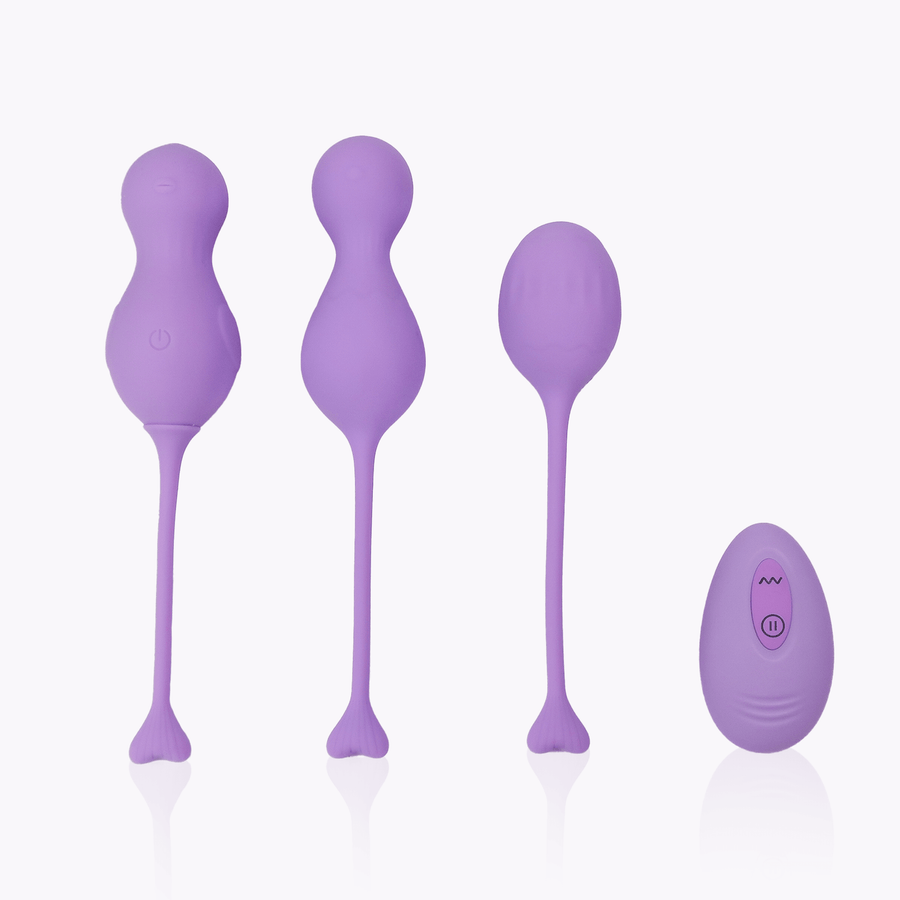Vaginal And Clitoral Orgasm
Vaginal Orgasm and Clitoral Orgasm: Their Key Differences
In the complex world of sexuality, women's orgasm experiences are an important issue. Women can experience two different types of orgasm: vaginal and clitoral orgasm. Both types of orgasms result from the stimulation of different anatomical regions and play an important role in ensuring women's sexual satisfaction. Here's a comprehensive review of the key differences between vaginal orgasm and clitoral orgasm:
- Anatomical Basis:
Vaginal orgasm and clitoral orgasm result from stimulation of different anatomical areas. Clitoral orgasm occurs as a result of intense stimulation of the clitoris. The clitoris is the most sensitive part of the female genital organ and its stimulation forms the basis of sexual satisfaction. Vaginal orgasm occurs with the stimulation of the walls inside the vagina and the G spot. Therefore, clitoral orgasm is focused on the clitoris, while vaginal orgasm is focused on the inside of the vagina.
- Intensity and Duration of Orgasm:
Clitoral orgasms tend to be more intense and short-lived. Because the clitoris has dense nerve endings, it responds quickly to stimulation and orgasm can be reached more quickly. Vaginal orgasm usually takes longer and its intensity may vary from woman to woman. Stimulation of the walls inside the vagina and the G-spot can cause different reactions among women.
3. Arousal Techniques:Direct clitoral stimulation is often an effective method for clitoral orgasm. By stimulating the clitoris carefully and with the right techniques, it can be easier for a woman to reach orgasm. For vaginal orgasm, it is important to stimulate the walls inside the vagina. This can be achieved by the movement of the penis inside the vagina during sexual intercourse or by manual internal stimulation.
- Instinctive and Learned Factors:
Clitoral orgasm can be experienced more easily and naturally for many women. The clitoris can be easily stimulated even without sexual intercourse. Vaginal orgasm may require more effort and experience for some women. Therefore, vaginal orgasm is thought to be a learned skill for some women.
- Psychological Effects:
The psychological dimension of orgasm should also be taken into account. Experiencing clitoral orgasm faster and easier may create less stress and performance anxiety among women. Vaginal orgasm may sometimes require more emotional commitment and trust. Therefore, communication and trust between partners are of great importance in experiencing vaginal orgasm.
As a result, women may have different experiences between vaginal and clitoral orgasm. Both types of orgasm are important for increasing women's sexual satisfaction and can occur with different stimulation techniques. Open communication between partners can contribute to enriching the sexual experience and making orgasm easier. It should not be forgotten that every woman is different and sexual experiences may vary individually. Therefore, it is possible to make sexual life more satisfying with mutual understanding and support.
Anatomy of Vaginal Orgasm and How Does It Occur?
Sexuality is an important aspect of human life, and orgasm is the culmination of this experience. Women can experience different types of orgasms, including vaginal and clitoral orgasms. Vaginal orgasm occurs as a result of stimulation of the walls inside the vagina and the G-spot. In this article, we will take a detailed look at the anatomy of vaginal orgasm and how it occurs.
- Anatomy of Vaginal Orgasm:
Vaginal orgasm occurs through appropriate stimulation of certain areas within the vagina. Stimulation of the G-spot, a point located on the front wall of the vagina, between the bladder and the uterus, is especially important. The G spot is approximately the size of a walnut and has a curved structure. There are also other sensitive areas and nerve endings along the vaginal walls, so intravaginal stimulation can contribute to a strong orgasm.
- How Does Vaginal Orgasm Occur?
The process of formation of vaginal orgasm occurs through the interaction of a number of physiological and psychological factors. This process usually begins with the cycle of sexual arousal and results in the woman experiencing pleasure and climaxing as a result of sexual intercourse or stimulation. Here are the steps that explain the process of vaginal orgasm.
A-Sexual Arousal:
Vaginal orgasm begins with sexual arousal. Sexual arousal means that a woman is sexually aroused, emotionally and physically. The process of arousal can begin with foreplay, touching, kissing, and other sexual activities. During this process, the woman's body reacts by increasing blood flow in the genital area and the tissues inside the vagina begin to swell.
Stimulation of the BG Point:
One of the most important points of vaginal orgasm is proper stimulation of the G-spot. Since the G-spot is located on the front wall of the vagina, between the bladder and the uterus, this area can be reached with appropriate positions and movements, especially during penetration. Stimulation of the G-spot can increase the intensity of orgasm and plays an important role in increasing a woman's sexual satisfaction.
C-Increasing Stimulation and Reaching the Climax:
The peak period of vaginal orgasm comes with increased sexual arousal and proper stimulation of the G-spot. Most women describe vaginal orgasm as a different sensation compared to clitoral orgasm. As the stimulation increases, the muscles and nerve endings inside the vagina are activated and a feeling of pleasure and tension occurs, indicating that orgasm is approaching.
D-Experiencing Orgasm:
Vaginal orgasm can be defined as the moment when stimulation reaches its peak and the woman reaches the peak of sexual pleasure. During orgasm, the muscles inside the vagina contract rhythmically and the woman experiences intense pleasure and satisfaction during this process. The duration of orgasm may vary from woman to woman, and while some women experience more intense and longer-lasting orgasms, for others the orgasm may last shorter.
As a result, vaginal orgasm occurs with proper stimulation of the walls inside the vagina and especially the G-spot. Women's sexual arousal and orgasm experiences may vary individually, and each woman's way of experiencing orgasm is unique.
Basic Causes of Clitoral Orgasm and How to Experience It?
Women can enrich their sexual experience with various types of orgasms. Clitoral orgasm is one of the most common and well-known types of orgasm experienced by women. Since the clitoris is the most sensitive part of the female genitalia, experiencing clitoral orgasm can be quite common and enjoyable for women. In this article, we will take a detailed look at the basic causes of clitoral orgasm and how it is experienced.
- Main Causes of Clitoral Orgasm:
The main causes of clitoral orgasm are associated with intense stimulation of the clitoris. The clitoris plays a critical role in sexual pleasure and orgasm because it has the densest nerve endings in the body. Stimulation of the clitoris contributes to increasing sexual pleasure and excitement and achieving orgasm. Here are some of the main causes of clitoral orgasm:
A-Sensitive Structure of the Clitoris:
The clitoris has a structure similar to a cappuccinomonkey, about the size of a grape. The visible part of the clitoris, called the clitoral head, is very sensitive and direct stimulation allows women to experience intense pleasure. The structure of the clitoris allows women to respond quickly to sexual stimulation and experience orgasm more easily.
B-Possibility of Direct Stimulation:
The clitoris is a sexual organ that can be directly stimulated even without vaginal stimulation. This feature makes clitoral orgasm easier to experience than other types of orgasm. Proper caressing of the clitoris, direct stimulation with fingers or tongue, can help achieve clitoral orgasm quickly and effectively.
C-The Relationship between Clitoris and Sexual Arousal:
Stimulation of the clitoris causes increased sexual desire in women, vaginal lubrication and contraction of the pelvic muscles. These physiological reactions are signs that orgasm is approaching and the woman has reached the peak of sexual pleasure. Clitoral orgasm occurs when these reactions intensify as a result of direct stimulation of the clitoris and orgasm is experienced.
- How to Experience Clitoral Orgasm?
Proper stimulation and experience are important for experiencing clitoral orgasm. How to experience clitoral orgasm may differ from woman to woman, but in general the following steps can contribute to experiencing orgasm:
A-Creating a Relaxation and Stimulation Environment:
For clitoral orgasm, it is important for the woman to be relaxed and in a suitable environment. Creating an environment of open communication and trust with her partner allows the woman to experience sexual arousal more easily. Foreplay, in particular, helps strengthen the emotional bond and prepare for the clitoris stimulation process.
B-Proper Stimulation of the Clitoris:
Proper stimulation of the clitoris is the key to clitoral orgasm. Caressing the clitoral head with light and rhythmic touches and gently stimulating it with the tongue or fingers increases the woman's sexual pleasure. The speed and pressure of clitoral stimulation should be adjusted according to the woman's preferences and reactions.
C-Increased Sexual Stimulation and Experience of Orgasm:
With the increase in clitoral stimulation, the woman feels increased sexual pleasure and excitement. Physiological reactions occur that indicate that orgasm is approaching, which may include contraction of the pelvic muscles, increased breathing rate, and increased heart rate. Clitoral orgasm occurs when the clitoris is stimulated intensely and sexual stimulation reaches its peak.
As a result, clitoral orgasm is a type of orgasm in which women experience intense sexual pleasure and satisfaction with appropriate stimulation of the clitoris. It is important to provide the appropriate environment for clitoral orgasm, to stimulate the clitoris correctly, and for the woman to relax with sexual stimulation. The process of experiencing orgasm may vary individually, so each woman's way of experiencing orgasm is unique.
Common Aspects and Similarities of Vaginal and Clitoral Orgasm
Sexuality is a satisfying experience that strengthens people's physical and emotional bonds. Women can experience different types of orgasms, including vaginal and clitoral orgasms. There are some basic similarities and commonalities between both types of orgasm. In this article, we will discuss in detail the commonalities and similarities of vaginal and clitoral orgasm.
- Physiological Responses:
Vaginal and clitoral orgasm lead to physiologically similar responses. In both types of orgasm, the female body reacts similarly during the sexual arousal process. Sexual arousal manifests itself in the body with symptoms such as increased heartbeat, accelerated blood flow, deepening of breathing and contraction of the pelvic muscles. These responses contribute to increased feelings of pleasure and satisfaction during vaginal and clitoral orgasm.
- Brain and Hormonal Effects:
Both types of orgasm trigger similar reactions in the brain. During orgasm, "happiness hormones" such as oxytocin and dopamine are secreted in the brain. These hormones help women feel sexual pleasure and pleasure, increase the intensity of orgasm, and create a general feeling of relaxation. The brain focuses on sexual pleasure during orgasm and the person's attention is focused on the sexual experience.
- Feeling of Pleasure and Satisfaction:
The most basic similarity between vaginal and clitoral orgasm is that they both give the woman a feeling of intense pleasure and satisfaction. Both types of orgasm provide sexual satisfaction to the woman and make her sexual experience more meaningful and enjoyable. This intense feeling of pleasure and satisfaction experienced during orgasm can positively affect a woman's sexual life and strengthen her bond with her partner.
- Emotional Connection with Partner:
Both vaginal and clitoral orgasms can strengthen the emotional connection with the partner. The oxytocin hormone secreted during orgasm increases the feeling of trust and closeness between people. Therefore, experiencing orgasm can positively affect the relationship with the partner and strengthen romantic bonds.
- Sexual Health and Satisfaction:
Vaginal and clitoral orgasm are important elements that increase women's sexual health and satisfaction. Both types of orgasm provide women with sexual satisfaction, increase desire for sexual intercourse and reduce stress. Since sexual health is important for general health and psychological well-being, women's orgasm is a part of a healthy sexual life.
In conclusion, the commonalities and similarities of vaginal and clitoral orgasm are important factors that make women's sexual experiences enriching and satisfying. Both types of orgasm provide women's sexual satisfaction, strengthen emotional bonds and provide positive effects on sexual health. In order to positively affect women's sexual lives, it is important to understand the importance of vaginal and clitoral orgasm and diversify their sexual experiences.
Variability and Individual Differences Among Orgasm Types
Sexual experiences can vary greatly between people, and orgasm is an important aspect affected by this. Women can experience different types of orgasms, including vaginal and clitoral orgasms. However, each woman's way of experiencing orgasm and her experiences may vary individually. In this article, we will discuss in detail the variability and individual differences between orgasm types.
- Differences in Sexual Anatomy:
The most fundamental variability between orgasm types lies in women's sexual anatomy. While vaginal orgasm occurs with appropriate stimulation of the walls inside the vagina and the G-spot, clitoral orgasm is experienced as a result of intense stimulation of the clitoris. Therefore, women's types of orgasms may differ depending on their sexual anatomy.
- Stimulation Methods and Techniques:
Women can experience orgasm with different stimulation methods and techniques. While clitoral orgasm can easily occur through direct stimulation of the clitoris, proper stimulation of the walls inside the vagina and the G-spot is important for vaginal orgasm. Some women experience clitoral orgasm more easily and quickly, while others may prefer vaginal orgasm. This may vary depending on women's sexual preferences, sensitivities and sexual experience.
- Psychological and Emotional Factors:
Orgasm experiences are also closely related to women's emotional state and mood. Feeling comfortable, safe, and emotionally connected can make it easier to experience orgasm. Psychological factors such as stress, anxiety and depression can make it difficult or delay orgasm. Therefore, emotional and psychological factors may have an impact on experiencing orgasm.
- Sexual Experience and Knowledge Level:
Sexual experience and knowledge level are also factors that affect orgasm experiences. Women who have more sexual experience can know their sexual bodies better and experience orgasm more easily. Likewise, being informed about sexual matters can help experience orgasm and increase sexual satisfaction.
- Relationship and Communication with Partner:
Orgasmic experiences also depend on the woman's relationship and communication with her partner. Having trust, openness and understanding with the partner can make orgasm easier. Communication between partners is important for orgasm and the quality of sexual experiences.
- Age and Hormonal Factors:
Women's age and hormonal status can also affect their orgasm experiences. Hormonal changes in postmenopausal women can cause a decrease in sexual desire and changes in the ability to experience orgasm. Likewise, hormonal changes during pregnancy and postpartum can also affect orgasm experiences.
As a result, variability and individual differences between orgasm types are an important issue that enriches and diversifies women's sexual experiences. Every woman has a unique way of experiencing orgasm, and this variation in sexual experiences is normal. Many factors, from sexual anatomy to psychological state, play a role among the factors that affect the experience of orgasm. Therefore, what is important for sexual health and satisfaction is for women to know themselves, communicate their needs and share their sexual experiences with their partners.
The Role and Importance of Vaginal and Clitoral Orgasm in Sexual Satisfaction
Sexuality has an important place in human life, and sexual satisfaction is an indicator of the pleasure and satisfaction individuals receive from their sexual experiences. Women can experience sexual arousal and orgasm in different ways. Vaginal and clitoral orgasm are the most common types of orgasm experienced by women and play an important role in sexual satisfaction. In this article, we will discuss the role and importance of vaginal and clitoral orgasm in sexual satisfaction in an impressive way.
- Definition of Sexual Satisfaction:
Sexual satisfaction is the person's sexual satisfaction and enjoyment of sexual experiences as a result of the process of sexual arousal. Each individual's perception and experience of sexual satisfaction may differ. Sexual satisfaction is a process that includes satisfying sexual desires, experiencing pleasure, increasing the feeling of confidence and relaxation.
- Definitions of Vaginal Orgasm and Clitoral Orgasm:
While vaginal orgasm occurs as a result of appropriate stimulation of the walls inside the vagina and the G-spot, clitoral orgasm is experienced by intense stimulation of the clitoris. While vaginal orgasm can generally be experienced with internal stimulants and sexual intercourse, clitoral orgasm is mostly experienced by directly stimulating the clitoris with hands or tongue. Both types of orgasm provide intense pleasure and satisfaction for women.
- Role of Vaginal and Clitoral Orgasm:
Both types of orgasm play an important role in sexual satisfaction. Vaginal orgasm can strengthen a woman's internal emotional connection and increase intimacy with her partner. Women who experience vaginal orgasm during sexual intercourse may feel more connected and satisfied. Clitoral orgasm occurs as a result of intense stimulation of the clitoris and can accelerate the sexual arousal process of women. Clitoral orgasm is an important type of orgasm for women in terms of sexual satisfaction and pleasure.
- Variety of Orgasm Types:
Diversity of orgasm types enriches sexual experiences and increases women's sexual satisfaction. Every woman may have different ways and experiences of vaginal and clitoral orgasm. The variety of orgasm types makes women's sexual lives more enjoyable and satisfying.
- Sexual Health and Its Role in Relationships:
Experiencing vaginal and clitoral orgasm can positively affect women's sexual health and relationships. Sexual satisfaction is an important element of women's sexual health, and achieving sexual satisfaction can increase their psychological and physiological well-being. At the same time, sexual satisfaction can strengthen the bond between partners and increase intimacy in romantic relationships.
- Sexual Information and Communication:
The role of vaginal and clitoral orgasm in sexual satisfaction is also closely related to sexual knowledge and communication. Openly discussing sexual preferences and expectations between partners can make it easier to experience orgasm and increase sexual satisfaction. At the same time, it is important for women to know their own sexual bodies and communicate their needs in achieving sexual satisfaction.
As a result, vaginal and clitoral orgasm are important types of orgasms that provide sexual satisfaction to women. Both types of orgasm diversify and make women's sexual lives enjoyable. The role of vaginal and clitoral orgasm in sexual satisfaction is closely related to sexual health, relationships and sexual knowledge. For women to know their own sexual bodies, communicate their needs, and communicate openly with their partners can make it easier to increase sexual satisfaction and experience orgasm.
SOURCES AND REFERENCES
Komisaruk, B.R., Wise, N., Frangos, E., Liu, W.C., Allen, K., & Brody, S. (2011). Women's clitoris, vagina, and cervix mapped on the sensory cortex: fMRI evidence. The Journal of Sexual Medicine, 8(10), 2822-2830.
Lloyd, E. A. (2005). The Case of the Female Orgasm: Bias in the Science of Evolution. Harvard University Press.
Wallen, K., & Lloyd, E. A. (2011). Female sexual arousal: Genital anatomy and orgasm in intercourse. Hormones and Behavior, 59(5), 780-792.
Jannini, E.A., Buisson, O., Rubio-Casillas, A., & Pfaus, J.G. (2014). Physiology of female sexual function: animal models. The journal of sexual medicine, 11(1), 26-37.
Komisaruk, B.R., Wise, N., Frangos, E., Liu, W.C., Allen, K., & Brody, S. (2011). Women's clitoris, vagina, and cervix mapped on the sensory cortex: fMRI evidence. The Journal of Sexual Medicine, 8(10), 2822-2830.
Whipple, B., & Komisaruk, B. R. (1991). Beyond the G-spot: Recent studies of female sexuality. The Journal of Sex Research, 28(4), 643-659.
Levin, R. J. (2011). The physiology of sexual arousal in the human female: a recreational and procreational synthesis. Archives of Sexual Behavior, 40(2), 377-402.
Komisaruk, BR, Beyer-Flores,
Komisaruk, B.R., Wise, N., Frangos, E., Liu, W.C., Allen, K., & Brody, S. (2011). Women's clitoris, vagina, and cervix mapped on the sensory cortex: fMRI evidence. The Journal of Sexual Medicine, 8(10), 2822-2830.
Jannini, E.
Öberg, K., & Fugl‐Meyer, A. R. (2002). On sexual well-being in sexually active Swedish women aged 13–79 years. Acta Obstetricia et Gynecologica Scandinavica, 81(7), 612-619.














Leave a comment